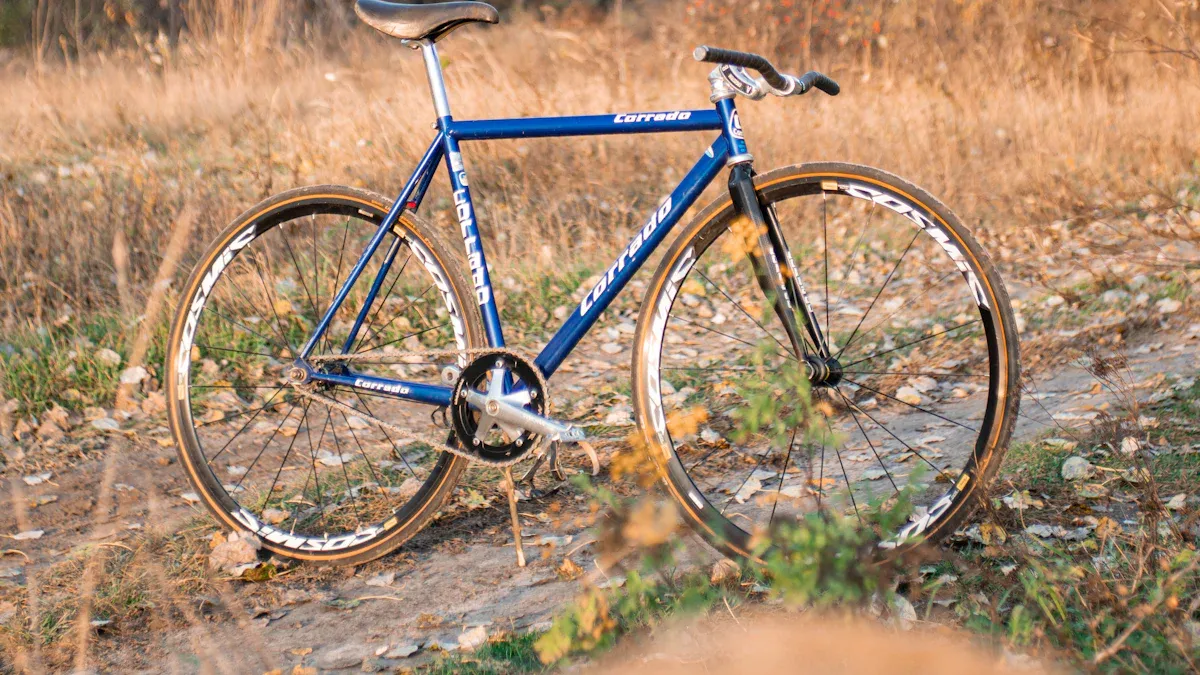
Choosing the right cyclocross bike frames is very important. The frame you select greatly affects how well you ride and how comfortable you feel on the bike. A cyclocross bike frame that fits you properly can enhance your overall riding experience, helping you feel less tired and reducing the risk of injury. For instance, studies show that riders using suspension cyclocross bike frames report feeling the least fatigued and the most comfortable. When selecting cyclocross bike frames, consider key factors like fit, materials, and shape. Each aspect plays a crucial role in how you control your bike across different surfaces. Paying attention to these details ensures your entire cyclocross bike works perfectly for you.
Key Takeaways
Choose a cyclocross bike frame that fits your body. This will help you feel comfortable and in control. It will also reduce tiredness during rides.
Pick frame materials like aluminum, carbon fiber, titanium, or steel. Your choice should depend on your budget, how long it lasts, and your riding style.
Look for bike shapes with a higher bottom bracket. Also, choose slacker head tube angles to handle rough ground better.
Make sure your bike has enough space for tires (at least 33mm). This will stop rubbing and help it work well in mud.
Set a budget that is realistic. It should balance quality and cost. This way, you can get a strong frame that lasts and saves money on repairs.
Frame Fit

Choosing the right frame size is very important. It helps with your comfort and performance on a cyclocross bike. A bike that fits well lets you ride longer without getting tired. When your bike fits right, you can control it better. This is especially true on tough terrain.
Sizing Differences
The size differences between cyclocross and road bikes can really affect how you perform. Here are some main differences:
Geometry: Cyclocross bikes have a higher bottom bracket and slacker head tube angles. This design helps with clearance and handling on mixed terrain. Road bikes have a lower bottom bracket and steeper head tube angles. This makes them faster and more responsive on smooth surfaces.
Tire Size: Cyclocross bikes usually have wider tires (30-40mm) with knobs. This gives better grip on different surfaces. Road bikes have narrower tires (20-25mm) that help reduce rolling resistance and go faster.
Weight: Cyclocross bikes are often heavier because of their strong frames and parts. They are made to handle off-road conditions. This extra weight can make them feel slower on smooth pavement compared to lighter road bikes.
Aspect | Cyclocross Bike Characteristics | Road Bike Characteristics | Impact on Rider Performance |
|---|---|---|---|
Geometry | More upright position, higher bottom bracket, slacker head tube angle | Lower bottom bracket, steeper head tube angle | CX geometry improves clearance and nimble handling on rough terrain; road geometry enhances speed and responsiveness on pavement |
Tire Size | Wider tires (30-40mm) with knobs for grip on mixed surfaces | Narrower tires (20-25mm), smooth for low rolling resistance | Wider tires increase rolling resistance and reduce speed on pavement; narrow tires optimize speed and efficiency on smooth roads |
Weight | Slightly heavier due to robust frame and components | Lighter weight optimized for speed | Heavier CX bike feels slower and less responsive on smooth terrain; lighter road bike is faster and more efficient |
Handling | Designed for quick steering and technical handling on mixed terrain | Designed for stability and quick responsiveness on paved roads | CX bike offers better maneuverability on technical courses but may feel less stable at high speeds; road bike offers stability and speed on smooth surfaces |
Versatility | Built to withstand rough terrain and impacts | Optimized for paved road racing | CX bike is versatile for off-road and mixed terrain racing; road bike specialized for road racing efficiency |
Checking Elbow Bend
Having the right elbow bend is very important for your control during cyclocross racing. Keeping your elbows bent and wide acts like a natural shock absorber. This helps you handle bumps and stay balanced. It also lets the bike move freely under you. A relaxed grip with flared elbows makes the bike respond better, especially on tricky or bumpy terrain. Stiff or sharply bent elbows can reduce traction and slow you down.
To find your best frame size, think about these key measurements:
Rider Height: Stand straight against a wall without shoes to measure your height.
Inseam Length: Stand with a book between your legs and measure from the floor to the top of the book. This helps find standover height.
Seat Tube Length: Measure from the center of the bottom bracket to the top of the top tube. This can change by brand.
Reach and Stack: These measurements help fit the bike to your body and riding style.
Here’s a quick reference for recommended bike frame sizes based on rider height:
Rider Height Range | Recommended Bike Frame Size (inches/cm) |
|---|---|
4’11” – 5’3″ | 13″ – 15″ (XS/SM) or 48 – 52 cm |
5’3″ – 5’7″ | 15″ – 17″ (SM/MD) or 50 – 54 cm |
5’7″ – 5’11” | 17″ – 19″ (MD/LG) or 54 – 57 cm |
6’0″ – 6’2″ | 19″ – 21″ (LG/XL) or 58 – 61 cm |
6’2″ – 6’4″ | 21″ – 23″ (XL/XXL) or 61 – 62 cm |
6’4″+ | 23″ – 25″ (XXL) or 63 cm plus |
By making sure your cyclocross bike frame fits well, you can feel less tired and ride better. A good fit helps with power transfer and comfort, which is key for cyclocross racing.
Frame Materials for Cyclocross

When you pick your cyclocross bike frame, the material is very important. It affects how well you ride, how comfortable you feel, and how long it lasts. Each material has special features that can change your riding experience. Here’s a look at the most common materials used for cyclocross bike frames:
Aluminum
Aluminum frames are popular because they are light and not too expensive. They give a good mix of performance and cost. But, they might not last as long as other materials. Aluminum frames can get dents or have paint problems with heavy use.
Weight: Aluminum frames usually weigh between 1,200 to 1,600 grams when painted.
Durability: They are reliable but may not handle impacts as well as steel or titanium.
Carbon Fiber
Carbon fiber frames are known for being very light and stiff. They do a great job of reducing vibrations, which makes your ride more comfortable. Many racers like carbon for its performance. However, they can cost more and can be damaged easily.
Weight: Carbon frames can weigh as little as 600 grams, depending on how they are made.
Durability: Carbon frames resist fatigue well but can crack with hard hits.
Titanium
Titanium frames mix the best features of steel and aluminum. They are light, strong, and resist rust. However, titanium frames are often made just for you, which makes them more costly.
Weight: Titanium frames usually weigh about the same as aluminum, around 1,200 to 1,600 grams.
Durability: They are very strong and can last a lifetime if taken care of.
Steel
Steel frames are known for being strong and comfortable. They absorb bumps well, giving you a smooth ride. While they are heavier than aluminum and carbon, many riders like how forgiving steel is.
Weight: Steel frames usually weigh more than aluminum, often over 1,600 grams.
Durability: Steel is very dependable and needs little maintenance, making it a smart choice for many riders.
Here’s a table that sums up the weight and durability of these materials:
Material | Density (g/cm³) | Approximate Raw Frame Weight Range (g) | Painted Frame Weight Range (g) | Durability Notes |
|---|---|---|---|---|
Aluminum (7005 alloy) | 2.8 | 1100 – 1500 | 1200 – 1600 | Less durable, prone to dents |
Titanium (3/2.5V) | 4.5 | Similar to aluminum (approx. 1100-1500) | Similar to aluminum (~1200-1600) | Extremely durable, long lifespan |
Steel (4130 chromoly) | 7.8 | Heavier than aluminum (exact range not specified) | Higher than aluminum and titanium | Very reliable, minimal maintenance |
Carbon Fiber | 1.6 (composite) | 600 – 1200 (varies by modulus and layup) | 700 – 1200 (painted varies by modulus) | High fatigue resistance, impact vulnerable |
Geometry of Cyclocross Bike Frames
The shape of your cyclocross bike frame is very important. It affects how the bike rides on different surfaces. Two main parts of the shape are bottom bracket drop and wheelbase length. Knowing these features helps you choose wisely.
Bottom Bracket Drop
Bottom bracket drop is the space between the bottom bracket and the wheel axles. For cyclocross bikes, this drop is usually between 55mm and 65mm. This is lower than the 70-74mm drop found in road bikes. A higher bottom bracket gives better pedal clearance. This helps prevent pedal strikes when turning sharply or getting back on the bike. Some newer cyclocross frames have a lower drop of about 70-73mm for better handling and stability.
A bigger bottom bracket drop makes the bike more stable, especially at high speeds. This helps your bike feel steady during fast descents and wide turns. On the other hand, a smaller drop can make the bike easier to steer but may feel shaky at high speeds. Many riders like a drop of around 60mm for a good mix of stability and agility.
Wheelbase Length
Wheelbase length greatly affects how your bike handles on tricky cyclocross courses. A shorter wheelbase lets you change directions quickly and makes it easier to go around tight corners. This is important when racing on tough terrain. However, a longer wheelbase makes the bike more stable at high speeds but can make sharp turns harder.
How your weight is spread between the front and back wheels also changes how the bike handles. Good weight balance helps you stay in control, especially on tricky parts of the course. Changing the wheelbase length can trade quickness for steadiness. Shorter wheelbases are better for quick handling, while longer ones offer more stability.
Features to Consider When You Buy a Cyclocross Bike
When you want to buy a cyclocross bike, think about some important features. These can make your ride better. Two main things to look at are tire clearance and brake types.
Tire Clearance
Tire clearance is very important for cyclocross bikes. You need enough space for wider tires, especially in muddy races. USA Cycling says you need at least 33mm of tire width clearance. This space allows for wider tires and mud, which is common in races. If your bike does not have enough clearance, the tires can rub. This can hurt performance and safety.
Brake Types
The type of brakes you choose can change how well you control the bike and stop. You usually have two choices: disc brakes and cantilever brakes.
Aspect | Disc Brakes | Cantilever Brakes |
|---|---|---|
Braking Power | More powerful and steady, especially off-road | Good for road and cyclocross; reliable but not as strong |
Weight | Adds about 1.5 to 2.5 pounds because of heavier parts | Lighter overall, making the bike lighter |
Maintenance | Hydraulic types self-center; need little bleeding | Easier to adjust and fix; simpler design |
Noise | Can be noisy, especially on road bikes | Usually quieter with fewer noise issues |
Tire Clearance | Can fit wide tires but depends on the frame design | Good space for wider tires, especially on steel frames |
Disc brakes give strong and steady stopping power. They are getting more popular in cyclocross because they work well in different conditions. But some riders still like cantilever brakes for their simplicity and lighter weight. Many cyclists enjoy how easy it is to set up and maintain cantilevers.
Also, a larger front triangle on your cyclocross bike can help when you need to carry it during races. This design gives you more room and comfort. A well-made front triangle helps you keep control and balance, especially during run-ups.
By thinking about these features, you can make a smart choice when you buy a cyclocross bike that fits your needs.
Budgeting for Cyclocross Bike Frames
Making a good budget for your cyclocross bike frame is very important. You need to find a balance between quality and price. A smart budget helps you not spend too much while getting a bike that fits your needs. Here are some price ranges to think about:
Frame Material | Example Bikes / Features | Price Details / Notes | |
|---|---|---|---|
Entry-level | Steel/Carbon | Bikes under $3,000 with carbon or steel frames | Around or below $2,000-$3,000; includes bikes like All-City Nature Cross (steel frame with carbon fork) |
Mid-range | Carbon | Giant TCX Advanced Pro 2, Canyon Inflite CF SL | $2,600 – $4,300; carbon frames with quality drivetrains (e.g., Shimano GRX-600, SRAM 1x) |
High-end | Advanced Carbon | Cannondale SuperSix Evo CX, Santa Cruz Stigmata | $4,000 and above; advanced carbon frames, high-end components (e.g., SRAM Force CX1, Rival AXS) |
Titanium | Limited offerings from boutique/custom builders | Higher price bracket due to material and rarity |
Cyclocross bike frames usually cost between $500 and $4,000. This price range is similar to road and mountain bike frames. Entry-level frames often use aluminum or steel. Mid-range options may have carbon frames with better parts. High-end frames mostly use advanced carbon fiber, which makes them lighter and stiffer.
When picking a frame, think about the value compared to the cost. Better-quality frames often need fewer repairs and last longer. For example, a cheaper bike might need repairs that can add up fast. Spending more on a good frame can save you money later.
Tip: Look for trusted brands that give good warranties. This can improve your long-term value. More expensive bikes usually have better design and parts, making them last longer.
Picking the right cyclocross bike frame is very important for how well you ride and how comfortable you feel. Here are the main points to remember:
Fit: Make sure the frame size fits your body. Different brands have different sizes, so check each one.
Materials: Decide between aluminum, carbon, titanium, and steel based on what you need and how much you can spend.
Geometry: Look for a higher bottom bracket and slacker head tube angles. This helps with handling on tough courses.
Budget: Set a budget that is realistic and balances quality with cost.
Think about flexible choices like the Cervélo R5-CX, which is great for racing and everyday use. Always ask for advice and try out different models to find the best fit for you. Enjoy your ride! 🚴♂️
FAQ
What size cyclocross bike frame should I choose?
Pick a frame size based on your height and inseam length. Use sizing charts from bike makers to help you. A good fit makes riding more comfortable and gives you better control.
How do I know if my cyclocross bike frame fits?
Look at your elbow bend when holding the handlebars. Your elbows should be a little bent and relaxed. This helps you balance and control the bike while riding.
What is the best material for a cyclocross bike frame?
The best material depends on what you need. Aluminum is light and not too expensive. Carbon fiber gives great performance but costs more. Steel is strong and comfy, while titanium is both strong and light.
How important is tire clearance on a cyclocross bike?
Tire clearance is very important for dealing with mud and debris. Make sure your bike has at least 33mm of clearance for wider tires. This stops rubbing and helps performance in tough conditions.
What type of brakes should I choose for my cyclocross bike?
Think about using disc brakes for better stopping power in different conditions. They work well in wet and muddy places. Cantilever brakes are lighter and easier but may not stop as strongly.
See Also
A Beginner’s Guide To Sizing Cyclocross Bike Frames
Selecting The Ideal Bike Frame To Match Your Needs
Factors That Determine The Perfect Bike Frame Fit
Choosing The Best Bike Frame Type For Comfort And Efficiency
